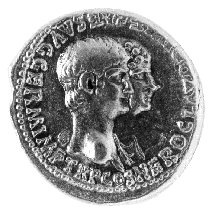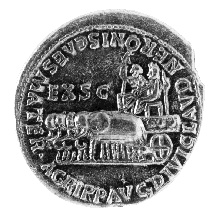



(73) Nero - AV aureus, A.D. 55, 7.60 g. (inv. 91.135).
Obverse: Jugate busts r. of Nero, bare-headed and draped
at back of neck, and Agrippina II, bare-headed and draped; NERO CLAVD(IVS)
DIVI F(ILIVS) CAES(AR) AVG(VSTVS) GERM(ANICVS) IMP(ERATOR) TR(IBVNICIA)
P(OTESTATE) CO(N)S(VL): Nero Claudius, son of a god (the Divine Claudius),
Caesar Augustus Germanicus, imperator, with tribunician power, consul.
Reverse: Quadriga of elephants l., bearing two chairs holding
two male figures, Divine Claudius, radiate, holding eagle-tipped scepter
in r., and Divine Augustus, radiate, holding patera in r. and scepter
in l.; above elephants, EXS C: by authority of the Senate; AGRIPP(INA) AVG(VSTA)
DIVI CLAVD(II) {supply uxor} NERONIS CAES(ARIS) MATER: Agrippina
Augusta, wife of Divine Claudius, mother of Nero Caesar.
Provenance: Stack's, 1983.
Bibliography: C.H.V. Sutherland, The Roman Imperial
Coinage I: from 31 BC to AD 69, rev. ed. (London 1984) 6.
The emperor Nero (Lucius Domitius Ahenobarbus Nero Claudius Caesar) was
the son of Domitius Ahenobarbus and Agrippina the Younger, but his mother
later married the emperor Claudius, who adopted him in A.D. 50. He married
Octavia, the daughter of Claudius, in A.D. 54 and became emperor in A.D.
55, when his ruthless mother poisoned Claudius.
Agrippina exerted powerful influence over her son at the beginning of his
reign, but Nero quickly began to assert himself and had her murdered in
A.D. 59. Her initial influence, however, is reflected in the early coinage
of Nero, in which she is depicted alongside the still youthful emperor.
Agrippina's portrait is very generalized, although she appears to have
some of the fashionable corkscrew curls that can be seen in her marble portraits.
Nero's portrait is beginning to acquire some of the features that became
more prominent as he grew older, the fleshiness in the chin and neck and
the mouth that recedes between his overhanging nose and rounded chin.
The figures with the radiate crowns in the quadriga on the reverse most
likely represent the two deified emperors, Augustus and Claudius; one of
Nero's first acts as emperor was the consecration of his step-father. Their
presence strengthened Nero's claim to the throne through relationship to
them. The elephant quadriga had been used on the coins of Tiberius honoring
Divine Augustus.
S.G.B.



All contents copyright (c) 1996.
Lawrence University
All rights reserved.